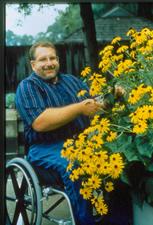Some people may think that gardening from a wheelchair is impossible, but this is not the case. Through making thoughtful choices and the right tools, can allow you to safely care for your plants, while making your garden a work of art.
Gardening Layout
 Begin your garden by planning the layout in a practical design. Take into consideration your limitations and the environment. Think about the seasons when you consider your layout, you may be able to maneuver very well during the summer, but will you be able to maneuver when the spring rains turn your grounds to swampy mud?
Begin your garden by planning the layout in a practical design. Take into consideration your limitations and the environment. Think about the seasons when you consider your layout, you may be able to maneuver very well during the summer, but will you be able to maneuver when the spring rains turn your grounds to swampy mud?
Create a well drained path for your garden to make moving easier. The ideal walkway is typically 4 feet wide. Add railings and ramps as well, to make sure you can access your garden at any point.
A wheelchair bound individual can greatly benefit from a raised bed, as these will make your flowers or vegetables more accessible from a wheelchair. Raised Beds can also create an appealing architectural element for your landscape. Beds should be around 16 inches high for individuals in wheelchairs, and the width should not be greater than 2 feet from a ledge, or it may be difficult to reach the center.
A “tabletop garden” is a good solution for plants that need a lot of hands on care. This garden will allow you to sit your legs under the table, and roll close to the table to work closely with the plants.
What Plants to Add
Trees always add character to a setting, but mature trees can require a lot of maintenance that can be difficult for someone in a wheelchair. Try planting Evergreens, as these do not need the amount of raking and bagging other trees do.
Choose hardy plants for your landscape, as these do not require a lot of chemicals, which means you won’t have to drag around spray. Native species will fare much better than using exotic plants.
If you want to incorporate more exotic plants, consider planting them in a container that is easy to reach. The addition of a pedestal to your container can create a stunning focal point for your setting. If at all possible, try to place the pot so the plant is at eye level, this way you can inspect the plant, but enjoy the beauty at the perfect height!
The Tools you Need
From a wheelchair, it will be necessary to have long handled tools for ground level tasks, as well as shorter tools for working in raised beds. It may be a good idea to invest in multiple sets so you always have the appropriate tool to make gardening safe, comfortable, and enjoyable.
Try incorporating specialized equipment to your garden routine, as some of these tools will eliminates some chores. Try placing landscaping fabric at the bottom of your bed, and putting mulch over it, this will greatly reduce the amount of weeding you will need to do. You can add an irrigation system to create automatic watering, or using a trellis will help vines to grow upwards making them easier to collect at harvest time.
Creating Your Perfect Environment
The appearance of an enabled garden for a wheelchair does not mean it will be an less beautiful that it’s non-accessible counterparts. All of the features that need to go into an enabled garden, the pathways, railings, trellises, and beds all add interest and beauty to enrich the environment.
A simple way to create a unified look is to use the same structural material throughout the garden. You can use a brick to build the raised beds as well as the pedestals. Or you can use the same wood to build walls, trellises, railings, and even planters.
It is best to unify most elements, and only leave a few elements standing out as focal points. If you are using a more rustic wooden look, a stunning wrought iron pedestal will add a delightful eye catching look.
An enabling garden for a wheelchair bound individual does not have to be boring or lacking creativity. By using these suggestions, the gardener can allow his or her creativity to thrive, and express them, resting a soothing and beautiful area.
